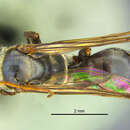Comprehensive Description
provided by Memoirs of the American Entomological Society
Anoplius (Anopliodes) parsonsi (Banks)
Psammochares parsonsi Banks, 1944, Bull. Mus. Comp. Zool., 94: 183-184 [Type: 9, Cuba: Buenos Aires, Trinidad Mts., 17-23 June 1923 (C. T. Brues) (MCZ, no. 25, 742)].
Anoplius {Anopliodes) parsonsi Evans, 1951, Trans. Amer. Ent. Soc., 76: 236238 (Florida).
This species occurs widely in Mexico and Central America, although not previously recorded from there. It is possible that the females here recorded from Panama actually belong to varius or to chiriqui, as I have seen no male parsonsi from south of Costa Rica, and the females of this complex are difficult to separate.
Female. — Length 10.5-15 mm. Black, pubescence largely dark, reflecting bluish in certain lights, often cinereous or silvery on the clypeus and lower front, in specimens from Costa Rica and Panama silvery on posterior part of hind coxae; abdomen wholly dark-pubescent, with no evidence whatever of banding. Wings strongly infuscated, with a somewhat darker outer marginal band. Apical margin of clypeus weakly concave; MID .48-.52 X TFD; UID .65-.72 X LID; antennal segment three equal to 1.25-1.45 X UID; POL equal to or slightly greater than OOL. Posterior margin of pronotum broadly, rather indistinctly angulate medially. Propodeum with the slope low, the declivity ill-defined, covered with long brownish or grayish hair. Wings and tarsal comb as described for varius.
Male. — Length 8-12 mm. Black, posterior margin of pronotum with a pale yellow stripe; wings hyaline, broadly and strongly infuscated apically. Body conspicuously patterned with silvery pubescence, as described for varius; T4 is extensively silvery in most Central American specimens, but there is enough variation in both varius and parsonsi to render this feature of little diagnostic value. S2-6 each with several long, dark setae, these setae distinctly more numerous on S4, but by no means forming a dense brush as in the preceding two species. SGP much like that of the preceding species, genitalia also very similar, but the digiti clothed with minute setae except for a very strong lateral fringe of sinuous setae (see fig. 79 in Evans, 1951, also fig. 43 in present paper).
Distribution. — Panama to Mexico (Sinaloa, Puebla) and to Cuba and Florida. Since my 1951 treatment of this species I have
Mop 46 Anoplius (Anopliodes) porsonsi (Banks)
seen numerous specimens from northern Florida (Levy and Putnam Cos.) and one from Alabama (Tuscaloosa Co.); it seems possible that the species has been spreading northward within recent years. (Map 46.)
Mexican and Central American specimens examined. — 15 9 9, 17 S $ . Panama: 4 9 9, Barro Colorado IsL, Canal Zone, Mch., JulyAug. (CWR) [KU, KSU]; 1 9, Progreso, Chiriqui Prov., 25 Apr. 1923 (F. M. Gaige) [U. Mich.]. Costa Rica: 1 9,2 S S, Turrialba, JuneJuly 1949 (KWC) [USNM]; 2 9 9,2 $ S , Pacuare, 1949 (KWC) [USNM]; 2 9 9, Monteverde, 1400 meters, Feb. (CWR) [KSU]. Honduras: 1 $ , Prieta, 4 April 1924 (JB) [MCZ]; 1 9, San Francisco, 20 Aug. 1956 (B. D. Valentine) [MCZ]. El Salvador: 3 s $ , Quezaltepeque, JuneJuly 1963 (M. Irwin) [UCD]. Guatemala: 1 $ , Cayuga, 15 June (W. Schaus) [USNM]. Mexico: Guerrero: 1 $ , 3 mi. N Taxco, 5500 feet, 1 June 1959 (HEE) [MCZ]. Veracruz: 1 S , Acayucan, 23 Oct. 1957 (RRD) [MSU]; 1 9, 3 H, Orizaba, 12 Aug. 1961 (RRD) [MSU]. Puebla: 1 S , Cuetzalan, N of Zacapoaxtla, 3450 feet, 19 June 1961 [KU]. Morelos: 1 9, Cuernavaca, 5500 feet, 5 June 1959
(HEE) [MCZ]; 1 S, Yautepec, 31 July 1963 (FDP, LS) [UCD]; 1 S , Tepoztlan, 18 Aug. 1956 (CY) [MCZ]. Mexico: 1 2, Valle de Bravo, 6500 feet, 3 Aug. 1962 (HEE) [MCZ]. Sinaloa: 1 2 , 3 km. E Mazatlan, 15 Aug. 1954 (Ryckman, Spencer, Christianson)
- bibliographic citation
- Evans, H.E. 1966. A Revision of the Mexican and Central American Spider Wasps of the Subfamily Pompilinae (Hymenoptera: Pompilidae). Memoirs of the American Entomological Society vol. 20. Philadelphia, USA

